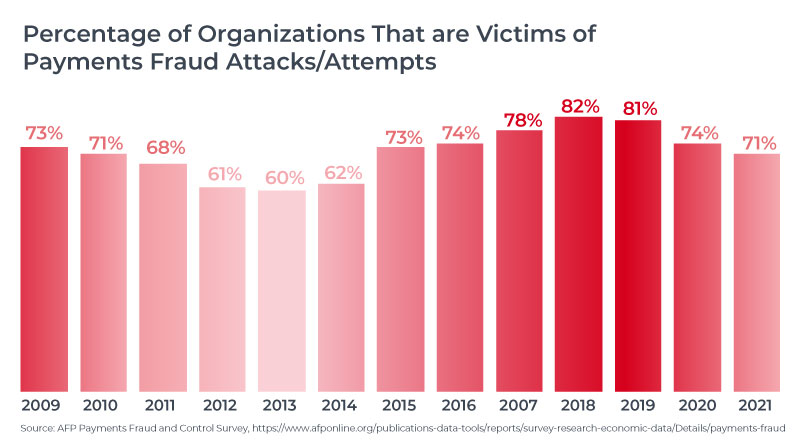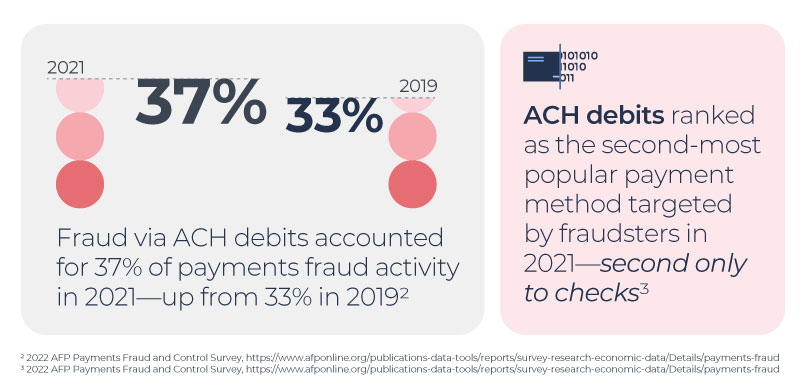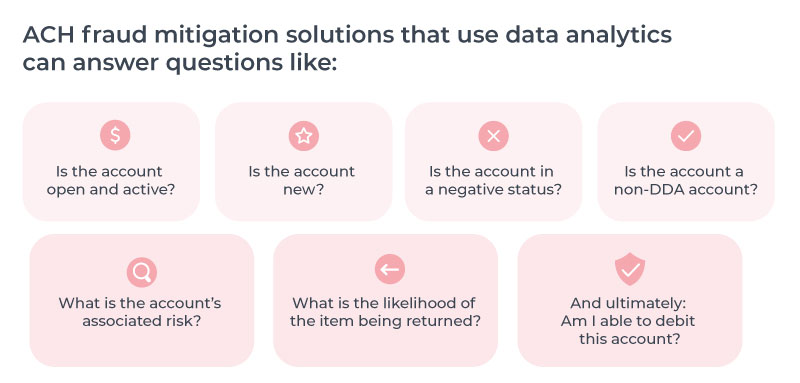ACH Payments Fraud is on the Rise: How to Use Big Data Analytics to Prevent Costly Attacks
Seventy-one percent of financial professionals reported that their organizations were impacted by payments fraud in 20211.
The good news? That’s the lowest level reported since 2014. After reaching a record high in 2018 and 2019 (with 80 percent of organizations impacted), payments fraud has been on the decline.
The not-so-good news? The battle is far from over. Despite recent decreases, the fact remains that most organizations—seven out of ten—are still facing payments fraud attacks. Specifically, ACH payments fraud.
In this post, we examine the current state of ACH payments fraud—and explain how data analytics, when used correctly, can prevent rising fraud losses.
Fraudsters are targeting ACH debits.
ACH payments fraud is on the rise—and it’s driving up costs associated with non-sufficient funds (NSF) and administrative returns.
The upward trend in ACH payments fraud activity, although relatively slight, reveals criminals’ focus on exploiting new and evolving payment systems. Indeed, as long as bad actors see ACH fraud as a lucrative gig, they will continue to leverage outdated technology systems and develop new tools for attacking online payment systems.
Along with FIs, government agencies, corporate payroll departments and financial lenders are some of the prime targets of ACH payments fraud due to the volume of high-dollar transactions they initiate on regular basis.
Without better fraud mitigation controls, these organizations will continue to suffer from rising collection and recovery costs.
The Nacha WEB Debit Rule aims to strengthen protections against ACH fraud.
As fraud trends evolve, new security regulations often follow. Such is the case with the Nacha WEB Debit Rule.
To combat increased criminal activity associated with online payments, the new rule requires ACH originators to validate a consumer's bank account information when setting up online debits.
Organizations that only require customers to enter their account and routing number for a payment—but neglect the account validation step—will not be considered compliant with the new Nacha rule.
To prevent ACH fraud and facilitate Nacha compliance FIs must be able to analyze the account’s payment risk in real-time, while simultaneously validating the account data provided.
Data analytics is a powerful tool for preventing ACH fraud.
- To prevent ACH payments fraud, FIs must be able to spot risky debits before pulling funds from a payer’s account—and they can do so by leveraging the power of big data analytics.
The answers to such questions, however, will only be useful if the source data is accurate, complete, and up to date.
With unique access to data from 2,500+ financial institutions, Early Warning® empowers FIs to leverage the full value of big data analytics to prevent ACH fraud—and provide better service to their institutional customers.
Our real-time payments fraud solution instantly identifies high-risk transactions and verifies account information. It provides the reliable intelligence needed to reduce NSF costs and administrative returns—while simultaneously satisfying the Nacha WEB Debit Rule.
Learn more about how Early Warning can help you harness the power of data analytics to prevent ACH fraud.



